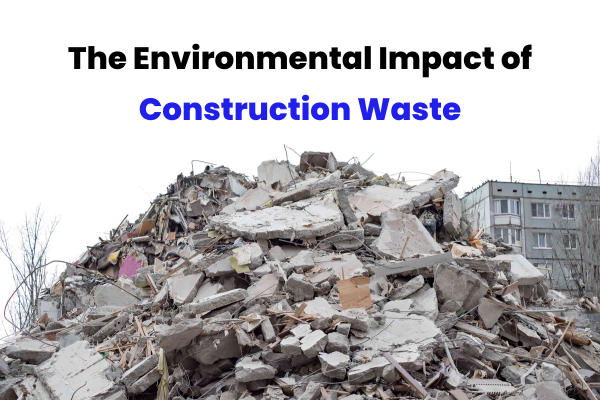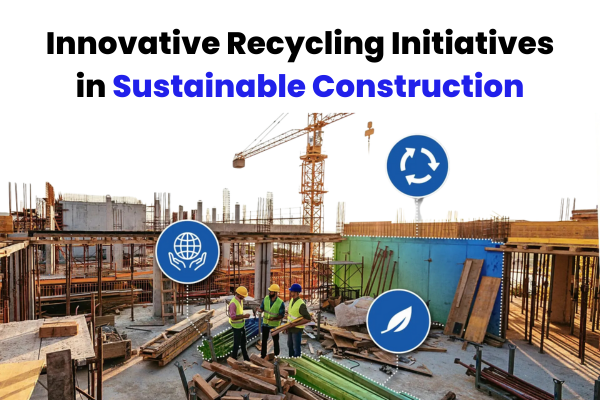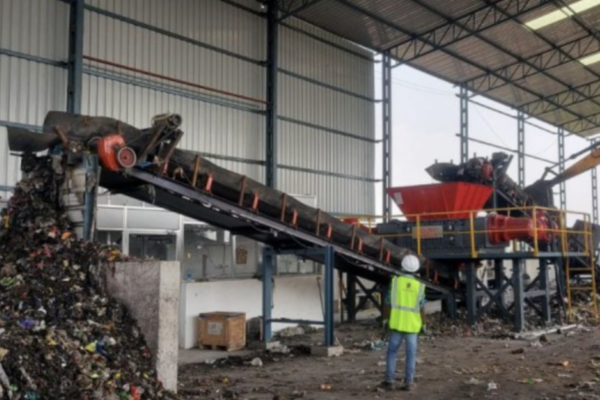Physical Address
From Trash to Treasure: Innovative Recycling Initiatives in Sustainable Construction Projects

Sustainable construction has become increasingly vital in today’s world, where environmental concerns loom large. As the construction industry Struggles with its significant environmental footprint, innovative recycling initiatives have emerged as a Light of hope. This article delves into the transformative journey of construction waste, turning it from trash into treasure through ingenious recycling practices.
If You Want To know about Material, That what type of material is included in Green Construction Practices or Sustainable Construction Practices: https://www.bigrentz.com/blog/sustainable-construction
Introduction to Sustainable Construction
Sustainable construction, also known as green building or eco-friendly construction, is an approach to designing, constructing, and operating buildings that aims to minimize their environmental impact while maximizing resource efficiency and occupant health and comfort. This concept encompasses various principles and practices that promote sustainability throughout the entire lifecycle of a building, from planning and design to construction, operation, maintenance, and eventual demolition or deconstruction.
Key Principles of Sustainable Construction:
- Energy Efficiency: Sustainable buildings are designed to minimize energy consumption and reduce greenhouse gas emissions by incorporating features such as efficient heating, cooling, and lighting systems, as well as utilizing renewable energy sources like solar panels and wind turbines.
- Resource Conservation: Sustainable construction aims to minimize the consumption of natural resources such as water, wood, and minerals by using recycled and eco-friendly materials, optimizing construction techniques to reduce waste, and promoting reuse and recycling of materials.
- Indoor Environmental Quality: Creating a healthy and comfortable indoor environment is essential for sustainable buildings. This involves ensuring good indoor air quality, adequate ventilation, natural lighting, and optimal thermal comfort for occupants while minimizing exposure to toxins and pollutants.
- Water Efficiency: Sustainable construction practices include implementing water-saving technologies such as low-flow fixtures, rainwater harvesting systems, and greywater recycling to reduce water consumption and minimize strain on local water resources.
- Site Selection and Management: Choosing an appropriate site for construction and implementing sustainable site management practices are crucial for minimizing environmental impact. This includes preserving natural habitats, minimizing disturbance to ecosystems, and managing stormwater runoff to prevent pollution.
- Lifecycle Assessment: Sustainable construction considers the environmental impact of a building throughout its entire lifecycle, from raw material extraction and manufacturing to construction, operation, and eventual disposal. Lifecycle assessment helps identify opportunities for reducing environmental footprint and improving overall sustainability.
The Environmental Impact of Construction Waste

Construction activities play a vital role in shaping the built environment, but they also leave behind a significant environmental footprint in the form of construction waste. This waste includes various materials and by-products generated during the construction, renovation, or demolition of buildings and infrastructure. The environmental impact of construction waste is a growing concern due to its potential to cause pollution, habitat destruction, biodiversity loss, and depletion of natural resources. In this discussion, we will explore the key environmental consequences of construction waste and examine strategies for mitigating its impact, highlighting the importance of sustainable practices in the construction industry.
Understanding the Concept of Recycling in Construction
Recycling in construction involves the systematic reuse of materials, components, and waste generated during building projects, contributing to sustainable practices and resource conservation. This concept encompasses various strategies aimed at reducing the environmental impact of construction activities while promoting efficiency and cost-effectiveness.
One key aspect of recycling in construction is the salvaging and reuse of materials such as wood, metal, concrete, and asphalt from demolition sites or renovation projects. These materials can be processed and refurbished for use in new construction, reducing the need for virgin resources and minimizing waste sent to landfills.
Additionally, recycling involves incorporating sustainable design principles that prioritize the use of recycled or renewable materials, such as recycled aggregates, reclaimed timber, and eco-friendly insulation.
Furthermore, construction waste management practices, such as sorting, segregation, and recycling of construction debris, play a crucial role in minimizing the environmental footprint of construction projects. Materials like concrete and asphalt can be crushed and reused as aggregate for new construction, while metals can be recycled for manufacturing purposes.
Overall, recycling in construction promotes circular economy principles by closing the loop on material flows, reducing resource depletion, and mitigating environmental pollution associated with construction activities. Embracing this concept not only aligns with sustainable development goals but also fosters innovation and resilience in the construction industry.
Innovative Recycling Initiatives in Sustainable Construction

- Utilizing Recycled Materials in Building Design: One of the primary strategies in sustainable construction is the incorporation of recycled materials into building design. This includes using reclaimed wood, recycled metal, and recycled plastic to construct various structural and non-structural elements.
- Implementing Advanced Sorting and Processing Techniques: Advanced sorting and processing techniques have revolutionized the recycling industry, enabling the extraction of valuable materials from mixed waste streams. Technologies such as optical sorting, magnetic separation, and robotic sorting enhance efficiency and purity in material recovery.
- Incorporating Circular Economy Principles: Circular economy principles emphasize the concept of ‘reduce, reuse, recycle’ to minimize waste generation and maximize resource efficiency. By adopting circularity in construction practices, stakeholders can design products and systems that are inherently sustainable and regenerative.
Case Studies of Successful Recycling Initiatives
- The Use of Recycled Plastic in Road Construction: Innovative initiatives, such as incorporating recycled plastic pellets into asphalt mixtures, have demonstrated promising results in road construction. Not only does this reduce the consumption of petroleum-based materials, but it also helps alleviate plastic pollution by giving discarded plastic a new life.
- Reclaimed Wood in Building Structures: Reclaimed wood from deconstructed buildings, old furniture, and shipping pallets has gained popularity as a sustainable building material. Its rustic charm and environmental benefits make it a preferred choice for eco-conscious architects and builders.
- Recycled Aggregates in Concrete Production: Recycled aggregates derived from crushed concrete and demolition waste offer a viable alternative to natural aggregates in concrete production. Besides conserving natural resources, recycled aggregates also contribute to lower greenhouse gas emissions associated with concrete manufacturing.
Benefits of Recycling in Sustainable Construction
- Reduction of Environmental Footprint: Recycling in sustainable construction significantly reduces the environmental footprint of building projects by conserving resources, minimizing waste generation, and mitigating pollution.
- Cost-effectiveness and Resource Efficiency: Incorporating recycled materials into construction projects can lead to cost savings through reduced material procurement and disposal expenses. Furthermore, recycling promotes resource efficiency by extending the lifespan of existing materials.
- Promotion of Circular Economy Principles: By embracing recycling initiatives, the construction industry fosters the transition towards a circular economy model, where materials are continuously reused, repurposed, and recycled, thus minimizing waste and maximizing value.
Challenges and Limitations
- Quality Control of Recycled Materials: Ensuring the quality and performance of recycled materials poses a significant challenge in sustainable construction. Variability in material composition and processing techniques may affect structural integrity and durability, necessitating stringent quality control measures.
- Regulatory Hurdles and Standards Compliance: Navigating regulatory frameworks and meeting standards compliance can pose obstacles to the widespread adoption of recycling initiatives. Regulatory uncertainty and lack of uniformity in recycling guidelines may deter investment and innovation in sustainable construction practices.
- Cultural and Behavioral Barriers: Cultural attitudes towards waste management and recycling vary widely across regions and communities. Overcoming ingrained behaviors and perceptions requires concerted efforts in education, awareness-raising, and incentivization.
Future Prospects and Trends in Recycling for Sustainable Construction

The future of recycling in sustainable construction looks promising, with continued advancements in technology, policy support, and stakeholder collaboration. Emerging trends such as 3D printing with recycled materials, modular construction, and digital twinning hold immense potential for transforming the industry.
Unique FAQs
How effective are recycling initiatives in reducing the environmental footprint of construction projects?
Recycling initiatives play a crucial role in minimizing the environmental footprint of construction projects by conserving resources, reducing waste generation, and mitigating pollution.
What are some challenges associated with the use of recycled materials in construction?
Challenges include ensuring the quality and performance of recycled materials, navigating regulatory frameworks, and overcoming cultural barriers towards waste management.
Are there any emerging trends in recycling for sustainable construction?
Yes, emerging trends include 3D printing with recycled materials, modular construction, and digital twinning, which hold immense potential for transforming the construction industry.
How can stakeholders promote the adoption of recycling initiatives in construction?
Stakeholders can promote adoption through policy support, incentivization, education, and awareness-raising campaigns to change cultural attitudes towards waste management.
What are the economic benefits of incorporating recycled materials into construction projects?
Incorporating recycled materials can lead to cost savings through reduced material procurement and disposal expenses, contributing to the overall economic viability of construction projects.
Conclusion
Innovative recycling initiatives are reshaping the landscape of sustainable construction, offering viable solutions to mitigate environmental impact and promote resource conservation. By harnessing the power of recycling, we can turn construction waste from a liability into a valuable asset, paving the way for a more sustainable and resilient built environment.

